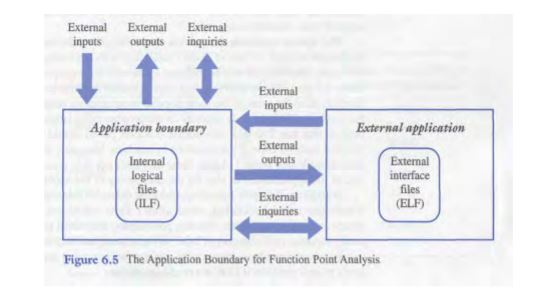
1. Internal Logical File (ILF) or Data Structures
- An ILF is a logical file that stores data within the application boundary.
- The complexity of an ILF can be classified as low, average, or high based on the number of data elements and subgroups of data elements maintained by the ILF.
- An example of a subgroup would be new customers for an entity called customer.
- Examples of data elements would be customer number, name, address, phone number, and so forth. In short, ILFs with fewer data elements and subgroups will be less complex than ILFs with more data elements and subgroups.
2. External Interface File (EIF)
- An EIF is similar to an ILF; however, an EIF is a file maintained by another application system.
- The complexity of an EIF is determined using the same criteria used for an ILF.
3. External Input (El) or User Inputs
- An El refers to processes or transactional data that originate outside the application and cross the application boundary from outside to inside.
- The data generally are added, deleted, or updated in one or more files internal to the application (i.e., internal logical files).
- A common example of an El would be a screen that allows the user to input information using a keyboard and a mouse.
- Data can, however, pass through the application boundary from other applications. For example, a sales system may need a customer's current balance from an accounts receivable system.
- Based on its complexity, in terms of the number of internal files referenced, number of data elements (i.e., fields) included, and any other human factors, each El is classified as low, average, or high.
4. External Output (EO)or User Outputs
- Similarly, an EO is a process or transaction that allows data to exit the application boundary.
- Examples of EOs include reports, confirmation messages, derived or calculated totals, and graphs or charts.
- This data could go to screens, printers, or other applications.
- After the number of EOs are counted, they are rated based on their complexity, like the external inputs (El).
5. External Inquiry (EQ)
- An EQ is a process or transaction that includes a combination of inputs and outputs for retrieving data from either the internal files or from files external to the application.
- EQs do not update or change any data stored in a file. They only read this information.
- Queries with different processing logic or a different input or output format are counted as a single EQ.
- Once the EQs are identified, they are classified based on their complexity as low, average, or high, according to the number of files referenced and number of data elements included in the query.
francis1897 answered the question on
March 14, 2023 at 05:59